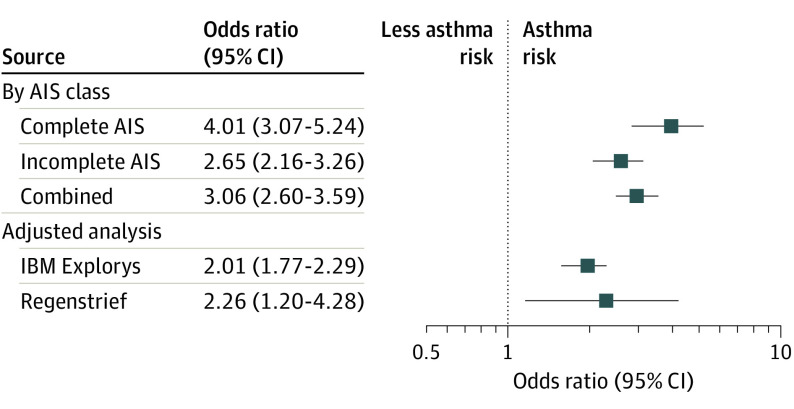Abstract
This study investigates whether androgen receptor deficiency is associated with increased asthma risk.
In studying why men have increased SARS-CoV-2 pneumonia risk, we discovered that androgen receptors (ARs) are expressed in human airways.1 Androgens may benefit asthma, and asthma prevalence is lower in men than in women.2,3 Indeed, AR-deficient mice have increased severity of antigen-induced airway inflammation and bronchoconstriction,4 and androgens are protective against allergic airway inflammation. We therefore hypothesized that in humans, as in the mice, AR deficiency would be associated with increased asthma risk.
Children and adults with complete androgen insensitivity syndrome (AIS; International Statistical Classification of Diseases, Tenth Revision, Clinical Modification code E34.51) or incomplete AIS (E34.52) have an inherited loss of AR.5 To our knowledge, the risk of asthma in human AR deficiency has not been studied.
Methods
We analyzed the prevalence of asthma in AIS among 76 200 860 unique patients in IBM Explorys using International Statistical Classification of Diseases, Tenth Revision, Clinical Modification codes for asthma (J45*). Individuals with AIS were compared with the rest of the cohort, and risk was adjusted for age category, obesity, and nicotine addiction using a logistic regression model. The analysis was repeated after excluding individuals with a history of nicotine addiction and those who simultaneously carried the diagnosis of chronic obstructive pulmonary disease (COPD) (J44*). In a validation study, we compared all patients with AIS with randomly selected age-matched control individuals (2 control individuals per patient with AIS) among approximately 18 million unique individuals in the Indiana Network for Patient Care Oracle database at the Regenstrief Institute. Institutional review board approval for deidentified data analysis was provided by the Cleveland Clinic (Explorys analysis) and Indiana University (Regenstrief analysis). Informed consent was not required owing to the use of deidentified data. Additional details can be found in the eMethods of the Supplement.
Results
In Explorys, 310 patients had complete AIS and 670 had incomplete AIS. Asthma prevalence was higher in patients with AIS (both complete and incomplete) than in unaffected individuals (18.4% vs 6.8%; P < .001). The odds ratio (OR) for having asthma was higher in complete than incomplete AIS vs control individuals (OR, 4.01; 95% CI, 3.07-5.24 vs 2.65; 95% CI, 2.16-3.26; Figure). Results were similar after excluding COPD and nicotine dependence for both complete AIS (3.89; 95% CI, 2.76-5.48; n = 220) and incomplete AIS (2.28; 95% CI, 1.76-2.99; n = 530). Asthma risk was also increased in all AIS after adjusting for age, obesity, and nicotine dependence (adjusted OR, 2.01; 95% CI, 1.77-2.29). Younger patients (<24 years; n = 130) also had a high OR for having asthma (3.35; 95% CI, 2.23-5.04; P < .001). However, the OR for those taking testosterone was 1.72 (95% CI, 1.14-2.58; P = .009; n = 130), lower than those not taking testosterone (3.35; 95% CI, 2.97-3.97; n = 1630; P < .001), further supporting a benefit of androgens in human asthma.3,4 In the validation cohort, there were 65 patients with complete and incomplete AIS and more than 130 age-matched control individuals. The adjusted OR for having asthma was 2.26 (95% CI, 1.2-4.28; Figure).
Figure. Loss of Androgen Receptor (AR) in Humans and Asthma Risk.
Consistent with murine data,4 electronic medical record–based analysis of more than 76 million unique patients in Explorys revealed that the odds of having any asthma diagnosis are more than 4 times those in the control group among patients with complete loss of AR function (androgen insensitivity syndrome [AIS]) and 2.65 times those in the control group in patients with partial AIS. Validation for the combined diagnosis was performed in a separate cohort of more than 18 million unique patients in the Indiana Network for Patient Care (Regenstrief), in which asthma risk was more than twice that of control patients in patients with any form of AIS.
Discussion
Androgen insensitivity syndrome is strongly associated with increased asthma risk. This risk is higher in complete than in partial AIS. Neither increased age nor COPD appeared to increase the risk, arguing somewhat against an effect of lifetime environmental confounders. Although there are sex-based differences in asthma risk between children and adults,2 both younger and older patients with loss of AR function were at comparable asthma risk in our analysis.
While large population studies are limited because they cannot identify granular details of clinical presentation and of mechanistic considerations, our data suggest that large, electronic medical record–based data sets may be useful for studying genetic deletions in human diseases and in sexually dimorphic diseases in particular. We demonstrate that patients, both young and old, with phenotypic evidence for AR deficiency have increased asthma risk. This information will be important to a variety of pediatric, medical, and surgical practitioners. Further, it suggests the possibility that androgen signaling could be exploited to therapeutic benefit in asthma. However, prospective human mechanistic studies remain to be performed.
eMethods.
References
- 1.Baratchian M, McManus JM, Berk M, et al. Sex, androgens and regulation of pulmonary AR, TMPRSS2 and ACE2. bioRxiv 2020:2020.04.21.051201. [DOI] [PMC free article] [PubMed]
- 2.Zein J, Gaston B, Bazeley P, et al. HSD3B1 genotype identifies glucocorticoid responsiveness in severe asthma. Proc Natl Acad Sci U S A. 2020;117(4):2187-2193. doi: 10.1073/pnas.1918819117 [DOI] [PMC free article] [PubMed] [Google Scholar]
- 3.Mohan SS, Knuiman MW, Divitini ML, et al. Higher serum testosterone and dihydrotestosterone, but not oestradiol, are independently associated with favourable indices of lung function in community-dwelling men. Clin Endocrinol (Oxf). 2015;83(2):268-276. doi: 10.1111/cen.12738 [DOI] [PubMed] [Google Scholar]
- 4.Fuseini H, Yung JA, Cephus JY, et al. Testosterone decreases house dust mite-induced type 2 and IL-17A-mediated airway inflammation. J Immunol. 2018;201(7):1843-1854. doi: 10.4049/jimmunol.1800293 [DOI] [PMC free article] [PubMed] [Google Scholar]
- 5.Batista RL, Costa EMF, Rodrigues AS, et al. Androgen insensitivity syndrome: a review. Arch Endocrinol Metab. 2018;62(2):227-235. doi: 10.20945/2359-3997000000031 [DOI] [PMC free article] [PubMed] [Google Scholar]
Associated Data
This section collects any data citations, data availability statements, or supplementary materials included in this article.
Supplementary Materials
eMethods.



